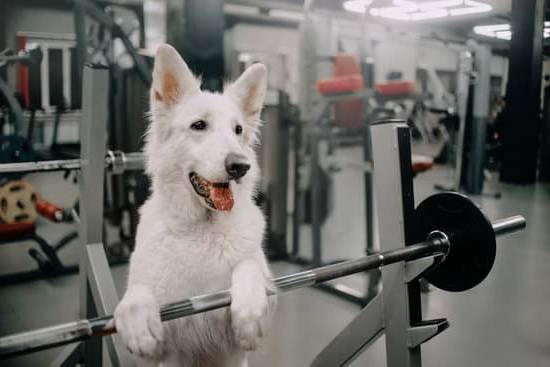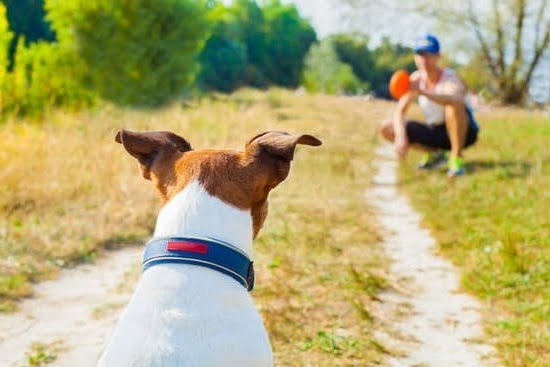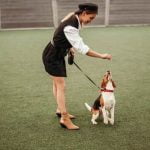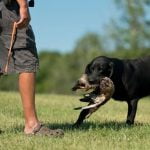Do you often find yourself stepping on toys scattered around your home? Teaching your dog to put away their toys not only helps keep your living space clean and organized, but it also has numerous benefits for your furry friend. In this article, we will explore the importance of training your dog to put away toys and its impact on their behavior and mental stimulation.
Having a dog that actively participates in cleaning up their toys can make a world of difference in maintaining a tidy environment. No more tripping over squeaky balls or hunting for missing puzzle pieces. But beyond the practical benefits, teaching your dog to put away toys can also have a positive impact on their overall behavior.
When dogs engage in playtime with their toys, it provides them with mental stimulation and the opportunity to release excess energy. By incorporating toy cleanup into their routine, you are reinforcing their training and encouraging them to be responsible for their belongings. This not only creates a sense of ownership but also fosters a more balanced state of mind.
Understanding the motivation and behavior behind your dog’s interaction with toys is essential when embarking on the training journey. Different breeds may have varying tendencies towards certain types of toys or exhibit specific behaviors during playtime. By recognizing these natural instincts, you can tailor your approach to suit your dog’s needs effectively.
Join us as we delve into the fascinating world of training dogs to put away toys. From selecting the right toys and establishing a foundation through commands, to introducing the concept of toy cleanup and troubleshooting common challenges, this comprehensive guide will equip you with all the necessary tools to transform your canine companion into an expert tidier-upper.
Understanding Your Dog’s Motivation and Behavior towards Toys
Dogs have a natural instinct to play with and possess toys. Understanding why your dog is motivated by toys and how their behavior towards them can vary is crucial when training them to put away toys. By gaining insight into their motivation and behavior, you can tailor your training methods to effectively teach your dog this valuable skill.
Exploring the natural instinct of dogs to play with and possess toys
Playing with toys is an innate behavior for dogs. It provides mental stimulation, relieves boredom, helps release energy, and satisfies their natural instincts. Dogs often view their toys as possessions or prey items, which stimulates their predatory nature.
When dogs engage in play with toys, they experience a surge of endorphins that promote feelings of joy and satisfaction. This positive experience reinforces their desire to engage in toy-related activities. By tapping into this instinctual drive, you can use it as a foundation for teaching your dog to put away their toys.
How different dog breeds might have varying tendencies with toys
Different dog breeds may exhibit varied tendencies when it comes to playing with toys. Some breeds were specifically bred for work or tasks involving retrieving objects, while others may have a stronger prey drive or enjoy interactive play.
Herding breeds, such as Border Collies or Australian Shepherds, often excel at retrieving tasks due to their natural ability to gather and control objects. Sporting breeds like Labradors or Retrievers also tend to have a strong affinity for fetching objects since they were bred for hunting and retrieving game.
Understanding the inherent characteristics of your dog’s breed can help tailor your training approach accordingly. While all dogs are capable of learning toy cleanup skills, some may require more patience or specific techniques based on their breed tendencies.
By understanding your dog’s motivation and behavior towards toys, you can establish a solid foundation for successful training. This knowledge will guide you in selecting the most effective training methods and reinforce the importance of toy cleanup for your canine companion.
Selecting the Right Toys for Training
When teaching your dog to put away toys, selecting the right toys for training is crucial. Not all toys are suitable for this specific purpose, so it’s important to choose ones that will facilitate learning and engagement. Here are some considerations when selecting toys for training:
- Toy Materials: Opt for toys that are durable and safe for your dog to interact with. Avoid toys that can easily be destroyed or chewed into small pieces, as they may pose a choking hazard. Look for materials such as rubber or sturdy plastic that can withstand regular use.
- Toy Sizes: Choose toys that are appropriate for your dog’s size and breed. A toy that is too small may be difficult for your dog to pick up or manipulate, while a toy that is too large may be overwhelming or difficult to carry around. Selecting appropriately sized toys ensures your dog can comfortably interact with them during the training process.
- Interactive Toys: Consider using interactive toys that engage your dog’s mental and physical capabilities. These types of toys often have compartments or features that require problem-solving skills to access treats or rewards hidden inside. By using interactive toys during training, you can enhance your dog’s mental stimulation while teaching them to put away their own toys.
- Variety of Toys: Introduce a variety of different types of toys during the training process. This helps prevent boredom and keeps your dog interested in learning how to put away their belongings. Include plush squeaky toys, rope tug toys, puzzle toys, and balls in the selection.
By carefully choosing appropriate toys for training, you set your dog up for success in learning how to put away their own belongings. Additionally, providing an assortment of engaging and interactive toys promotes mental stimulation and keeps your furry companion entertained even outside of training sessions.
Establishing a Foundation
Teaching your dog to put away toys requires a strong training foundation built on basic commands. Before introducing the toy cleanup command, it is essential to establish a solid understanding of fundamental commands such as “sit,” “stay,” and “come.” These foundational commands provide the structure and communication necessary for successful toy cleanup training.
To begin, start with teaching your dog the “sit” command. This command teaches your dog to sit down and wait for further instructions. Start by holding a treat close to your dog’s nose, then slowly move it upward while saying “sit.”
As your dog follows the treat with its eyes and moves into a sitting position, reward them with praise and the treat. Repeat this process several times until your dog consistently responds to the verbal command without needing the treat as guidance.
Next, move on to teaching the “stay” command. This command is vital during toy cleanup training as it ensures that your dog remains in place until you give further instructions. Start by commanding your dog to sit, then extend your hand out with an open palm in front of their face while saying “stay.”
Take a small step backward and if your dog remains still, immediately reward them with praise or a treat. Gradually increase the distance and duration of the stay command over time.
Lastly, introduce the “come” command to teach your dog to come towards you when called. Begin by kneeling down or crouching, then call out your dog’s name followed by “come.” Use an enthusiastic tone of voice and encourage them by patting your knees or slapping your thighs. When they come towards you, shower them with praise or offer a tasty treat as a reward. Practice this command in different environments and gradually increase distractions to reinforce its reliability.
By establishing these basic commands early on in training, you create a solid foundation for introducing more advanced concepts like toy cleanup. A well-trained dog that understands basic commands will be more receptive and responsive to the toy cleanup command, resulting in a smoother and more successful training process. Remember to be patient, consistent, and always reinforce positive behavior with praise or rewards.
Introducing the Toy Cleanup Command
Teaching your dog to put away their toys is not only a practical skill, but it can also contribute to their overall mental stimulation and behavior. Introducing the toy cleanup command takes time and patience, but with consistent training, your dog will learn to enjoy tidying up their play area. This section will provide you with effective techniques to introduce your dog to the concept of cleaning up toys.
To effectively introduce the toy cleanup command, it is important to capture your dog’s attention and establish the association between the command and the action. Start by using a designated area for toy storage that is easily accessible and identifiable. Begin by picking up a toy yourself and saying the command “cleanup” or any other suitable word you choose consistently.
When your dog shows interest in the toy, encourage them to approach it using positive reinforcement such as praise or treats. As they interact with the toy, give them verbal cues such as “bring it” or “take it” to encourage them to pick up the toy. When they have successfully done so, reward them again with praise or a treat.
As training progresses, gradually increase complexity by introducing multiple toys and asking your dog to pick up specific ones. Use different toys each time to reinforce that this behavior applies universally regardless of the object being picked up. Consistency in training sessions is key – practice regularly in short sessions to prevent both boredom and frustration.
Remember that every dog learns at their own pace, so be patient throughout this process. Keep sessions positive and enjoyable for both you and your furry friend. With time, practice, and plenty of encouragement, you’ll have a well-trained canine companion who happily helps maintain a neat space.
Using Positive Reinforcement and Rewards
Positive reinforcement is a crucial element in training your dog to put away toys. By using positive reinforcement techniques, you can motivate your dog and make the training experience enjoyable for both of you. It is important to remember that different dogs have different preferences when it comes to rewards, so finding what motivates your dog is key.
The Role of Positive Reinforcement
Positive reinforcement involves rewarding your dog for exhibiting desired behaviors. When your dog successfully puts away toys, it is important to immediately praise or reward them. This will help them understand that their actions are valued and encourage them to repeat the behavior in the future.
Effective Reward Systems and Treats
Choosing the right rewards for your dog is essential. Treats are often a popular choice for positive reinforcement, but it’s important to use treats that are safe and appropriate for your dog’s health and dietary needs. You can also experiment with other types of rewards such as verbal praise, petting, or playtime.
It’s important to keep in mind that each dog is unique and will respond differently to various types of rewards. Some dogs may be highly motivated by food treats, while others may be more responsive to verbal praise or playtime with a favorite toy. Pay attention to what truly excites and motivates your dog during training sessions, and tailor the rewards accordingly.
Using positive reinforcement and rewards not only helps create a positive association with cleaning up toys but also strengthens the bond between you and your furry friend. With patience, consistency, and the right incentives, you’ll find that your dog quickly learns to put away toys with enthusiasm.
Breaking Down the Steps
Teaching your dog to put away toys is a process that involves breaking down the task into smaller steps. One of these steps is teaching your dog to retrieve toys on command and place them in a designated area. This section will provide progressive training techniques for teaching toy retrieval and placement.
To begin, it is important to establish a strong foundation of basic commands such as “sit,” “stay,” and “come.” These commands will serve as building blocks for teaching your dog to retrieve and place toys. Practice these commands regularly and ensure that your dog has a solid understanding before moving on to the next step.
Once your dog is proficient in basic commands, you can start introducing the concept of toy retrieval. Start by placing a toy just a few feet away from your dog and use the command “fetch” or any other cue you prefer. Encourage your dog to retrieve the toy by using positive reinforcement such as praise or treats. Repeat this step several times until your dog consistently retrieves the toy when given the command.
After your dog has mastered retrieving toys, you can move on to teaching them where to place the toys. Choose a specific spot in your home where you want your dog to put away their toys, such as a basket or box.
Begin by holding out the toy towards the designated spot and commanding your dog to “drop it” or any other cue that indicates they should release the toy. Use positive reinforcement when they successfully place the toy in the designated area.
Gradually increase the distance between where your dog retrieves the toy and where they have to place it, making sure to reinforce positive behavior at each stage. You can also introduce verbal cues specific to placing toys, such as “put it away” or “toy box.” With consistency and repetition, your dog will learn to associate these cues with putting away their toys.
Progressive Training Techniques for Teaching Toy Retrieval and Placement
| Step | Description |
|---|---|
| Step 1 | Teach basic commands such as “sit,” “stay,” and “come” to establish a foundation. |
| Step 2 | Introduce toy retrieval by placing a toy a few feet away and using a command like “fetch.” |
| Step 3 | Teach your dog to place the retrieved toy in a designated area, using cues like “drop it” or “put it away.” |
| Step 4 | Increase the distance between retrieval and placement gradually, reinforcing positive behavior at each stage. |
By following these progressive training techniques, you can effectively teach your dog to retrieve toys on command and place them in a designated area. Remember to be patient and consistent throughout the process, as it may take time for your dog to fully grasp the concept. With practice and positive reinforcement, you will soon have a well-trained dog who actively participates in tidying up their toys.
Repetition and Consistency
Once you have successfully introduced the toy cleanup command to your dog and they are starting to grasp the concept, it is essential to emphasize the importance of repetition and consistency in order to maintain training success. Consistency is key in reinforcing the desired behavior and ensuring that your dog understands what is expected of them. Here are some tips to help you maintain training success through repetition and consistency:
- Practice Regularly: Make sure to incorporate toy cleanup training into your daily routine. Set aside specific times each day for training sessions dedicated to practicing toy retrieval and placement. Consistency in practice will reinforce the behavior and establish a habit for your dog.
- Gradually Increase Difficulty: Once your dog has mastered retrieving and placing toys in a designated area, gradually increase the difficulty level. Begin by asking them to retrieve toys from different rooms or areas of the house, then progress to more challenging scenarios such as asking them to find specific toys or sort them into categories.
- Reinforce Positive Behavior: Continuously reward and reinforce your dog’s positive behavior during toy cleanup training. Use verbal praise, treats, or other rewards that motivate your dog. Consistently rewarding successful toy cleanup will encourage your dog to continue performing the desired actions.
- Set Realistic Expectations: Remember that each dog learns at their own pace, so be patient with their progress. It may take time for them to fully understand and consistently perform the toy cleanup routine. Celebrate small victories along the way to keep both you and your dog motivated.
- Maintain a Structured Environment: Keep your home organized and establish designated areas for toys. This will help reinforce the association between specific locations and toy cleanup for your dog. Consistently placing toys in these designated areas will also make it easier for your dog to identify where they should be putting their toys away.
By maintaining repetition and consistency in your training sessions, you can ensure that your dog continues to excel in the toy cleanup routine. Remember, consistency is key in reinforcing the behavior and maintaining a well-trained and organized dog. With time and practice, you will be able to enjoy a clean and organized space with a trained dog who actively participates in maintaining a tidy environment.
Troubleshooting Common Challenges
Training a dog to put away toys can sometimes be a challenging task. Despite our best efforts, we may encounter common obstacles that hinder the progress of our training. This section will provide strategies to overcome these challenges and ensure success in teaching your dog to clean up their toys.
One common challenge owners face is a lack of interest from the dog in cleaning up toys. Some dogs may simply not find tidying up as appealing as playing with the toys. To address this, it is important to make the cleaning process fun and rewarding for your dog.
You can try using interactive toy storage solutions, such as puzzle toys that dispense treats when toys are placed inside them. This will not only make cleaning more exciting but also provide mental stimulation for your dog.
Another challenge is distractions that may deter your dog from completing the cleanup task. Dogs are naturally curious creatures and may easily get sidetracked by other interesting things in their environment. To combat this, create a designated area specifically for toy cleanup training where there are minimal distractions. Gradually increase the level of distractions as your dog becomes more proficient at putting away toys.
| Common Challenge | Strategies to Overcome |
|---|---|
| Lack of Interest | – Make cleaning fun and rewarding with interactive toy storage solutions
|
| Distractions | – Create a designated area for training with minimal distractions
|
Overall, troubleshooting common challenges in training your dog to put away toys requires patience and creativity. By implementing these strategies, you can overcome obstacles and ensure a successful training experience for both you and your furry friend.
Celebrating Success and Progress
Training your dog to put away toys is a journey that requires dedication and patience. As you go through the various stages of training, it is important to take time to celebrate the successes and progress that you and your dog achieve together. This section will explore the importance of celebrating along the way and provide tips for recognizing your dog’s achievements throughout the training process.
One way to celebrate your dog’s success is through positive reinforcement. When your dog successfully retrieves and places a toy in the designated area, make sure to give them praise and rewards. This can be done through verbal cues such as saying “good job” or “well done,” as well as physical affection like petting or giving treats. By associating this positive response with their actions, your dog will feel motivated and encouraged to continue learning.
Another way to celebrate progress is by setting milestones throughout the training process. For example, once your dog consistently retrieves and places toys in the designated area for a certain period, you can consider it a milestone achieved. Celebrate by giving them extra attention or a special treat that they love. These small celebrations not only motivate your dog but also serve as markers of their growth and accomplishments.
In addition to celebrating individual achievements, it is important to appreciate the overall progress that you and your dog make together. Reflect on how far you have come since starting the training journey and acknowledge the effort that both you and your dog have put in. Remember that training takes time, so even small improvements should be celebrated as steps toward success.
| Ways to Celebrate Success | Benefits |
|---|---|
| Positive reinforcement: praise, pets, treats | Motivates continued learning |
| Setting milestones throughout training | Provides markers of growth and accomplishments |
| Reflecting on overall progress | Acknowledges effort and serves as encouragement |
By celebrating your dog’s success and progress, you not only create a positive training experience but also strengthen the bond between you and your furry companion. Remember to be patient with both yourself and your dog throughout the process, as training requires time and consistency. With dedication, celebration, and a well-trained dog by your side, you can enjoy a clean and organized space together.
Conclusion
Teaching your dog to put away toys is not just about tidiness, but also about building a strong bond and fostering mental stimulation for your furry friend. By following the steps outlined in this article, you can enjoy a clean and organized space while having a well-trained and cooperative dog.
One of the key benefits of training your dog to put away toys is the impact it has on maintaining a tidy environment. With a trained dog, you no longer have to worry about tripping over scattered toys or constantly picking up after your pet. Instead, you can relax and enjoy a clutter-free space, knowing that your dog will take responsibility for their belongings.
Moreover, teaching your dog to put away toys serves as an opportunity for growth and enrichment for them. By engaging in this training, your dog receives mental stimulation and exercises their natural instincts. The tasks involved in toy cleanup provide mental challenges that stimulate their problem-solving skills. This mental stimulation is essential for their overall well-being and helps prevent boredom-related behavior problems.
As you progress through the training process, it is important to celebrate every achievement and milestone with your dog. Recognizing their progress not only motivates them further but also deepens the bond between you both. Remember that training takes time, patience, and consistency, so be sure to acknowledge both big and small accomplishments along the way.
In conclusion, training your dog to put away toys is a rewarding endeavor that has multiple benefits – from enjoying a clean and organized living space to providing mental stimulation for your beloved pet. Through positive reinforcement techniques, consistent practice, and an understanding of your dog’s motivation towards toys, you can achieve success in teaching this valuable skill to your four-legged companion.
So start today and create a harmonious environment where both you and your trained dog live happily ever after.

Welcome to the blog! I am a professional dog trainer and have been working with dogs for many years. In this blog, I will be discussing various topics related to dog training, including tips, tricks, and advice. I hope you find this information helpful and informative. Thanks for reading!





